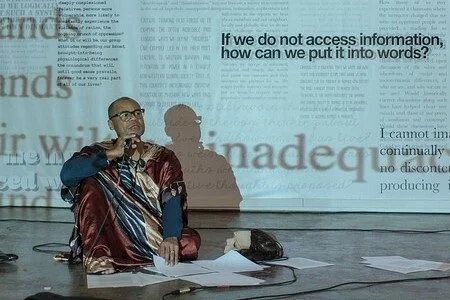For her debut solo exhibition, Laura Ortiz Vega presented a new series of thread paintings inspired by the rhetoric surrounding President Trump’s proposed US-Mexico border wall and by her documentation of graffiti in Mexico City, Canada, and other cities she had travelled.
Read MoreThese connected projects — related to bees, beekeeping, culture, and community — include an outdoor installation and a resulting exhibit developed by Juan William Chávez, an artist and cultural activist based in St. Louis, during his six-week residency at Tube Factory.
Read MoreDeeply rooted in place, Land Art (Telling Trees) was inspired by a large-scale fire that tore apart the island of Samos, Greece — the birthplace of the artist.
Read MoreHeritage is a pressing concern to our generation. Should we allow the past to influence us—are we bound to ancient tools, materials and techniques? Or should we endeavor to make work that is specific to our time, embracing technology and its untested, ambivalent ramifications?
Read MoreKeeper of My Mothers’ Dreams expanded the dialogues began in Crowe Storm’s works Her Name is Laura Nelson and Be/Coming with newly commissioned pieces: Poems, Origin and Sister Song.
Read MoreAriana Reines discusses Ouvrior de Theologies Potentielles at the closing of the Larissa Hammond exhibit. Known for her interest in bodily experience, the occult, new media, and the possibilities of the long or book-length form, Reines has been described as “one of the crucial voices of her generation” by Michael Silverblatt on NPR’s Bookworm.
Read More“The/a mind the b mind” was a fully commissioned exhibit, featuring four large-scale paintings by Larissa Hammond and one in collaboration with poet Ariana Reines.
Read MoreThe legendary Jack Johnson (1878–1946) was a true American creation: challenging white boxers—and white America—to become the first African-American heavyweight world champion. The Big Smoke, Adrian Matejka’s third work of poetry, follows the fighter’s journey from poverty to the most coveted title in sports through the multi-layered voices of Johnson and the white women he brazenly loved.
Read MoreChicago-based artist Carlos Rolón/Dzine presented a dually charged exploration of boxing and domestic culture, inspired by the tactility and performative qualities of boxing, and its relationship to contemporary art.
Read MorePrince Rama is the musical duo of sisters Taraka and Nimai Larson. They have lived in ashrams, worked for utopian architects, written manifestos, delivered lectures from pools of fake blood, conducted group exorcisms disguised as VHS workouts, installed art installations at The Whitney, Art Basel, and various galleries across the U.S.
Read MoreDrawing largely from a stack of 45 rpm phonograph records, Selector Dub Narcotic is known to mix the genres dancehall, soul, punk, garage, R&B, rock steady, bubblegum and rockabilly with assorted curiosities of the current underground music scene.
Read MorePart of the programming with the Carl Pope: Mari Evans exhibition, Tube Factory artspace hosted Jill is Black, a writer, blogger, and facilitator/trainer/lecturer, focusing on issues of Race, Power, and Privilege in modern-day America.
Read MoreAs part of the programming with the Carl Pope: Mari Evans, Tube Factory artspace brought Ronaldo V Wilson for a reading and performance.
Read MoreOne of the founders of the Black Arts Movement and longtime Indianapolis resident, poet and author Mari Evans also worked as a producer, writer, and director of “The Black Experience” (1968-1973) — a history documentary that aired on prime time in Indianapolis.
Read MoreMari Evans:Carl Pope revolved around Indianapolis-based writer Mari Evans. One of the founders of the Black Arts Movement and longtime Indianapolis resident, Evans published her first work “Where Is All the Music” in 1968 followed by “I Am a Black Woman” in 1970. During this time, Evans also worked as a producer, writer, and director of “The Black Experience” (1968-1973) — a history documentary that aired on prime time in Indianapolis.
Read MoreDetroit-based Scott Hocking visited Indianapolis in January 2015 and selected the former RCA Factory at Michigan and LaSalle as fodder for his installation. Hocking spent three weeks in Indianapolis gathering materials from the site, documenting, researching, and creating. The resulting installation uses the main gallery as a kind of ceremonial site — the burned Styrofoam mountain could be a dystopian temple or future glacier.
Read MoreBen Valentine is an independent writer and curator studying how technology, media, and politics intersect around the world. He has helped nonprofits and arts organizations on three continents with marketing, bolster their online presence, and organize public events.
Read MoreThe People’s 500 was an exploration of the relationship between the Indianapolis Motor Speedway and the people of Indianapolis, marking the 100th Running of the Indianapolis 500 that opened in May of 2016.
Read More


















